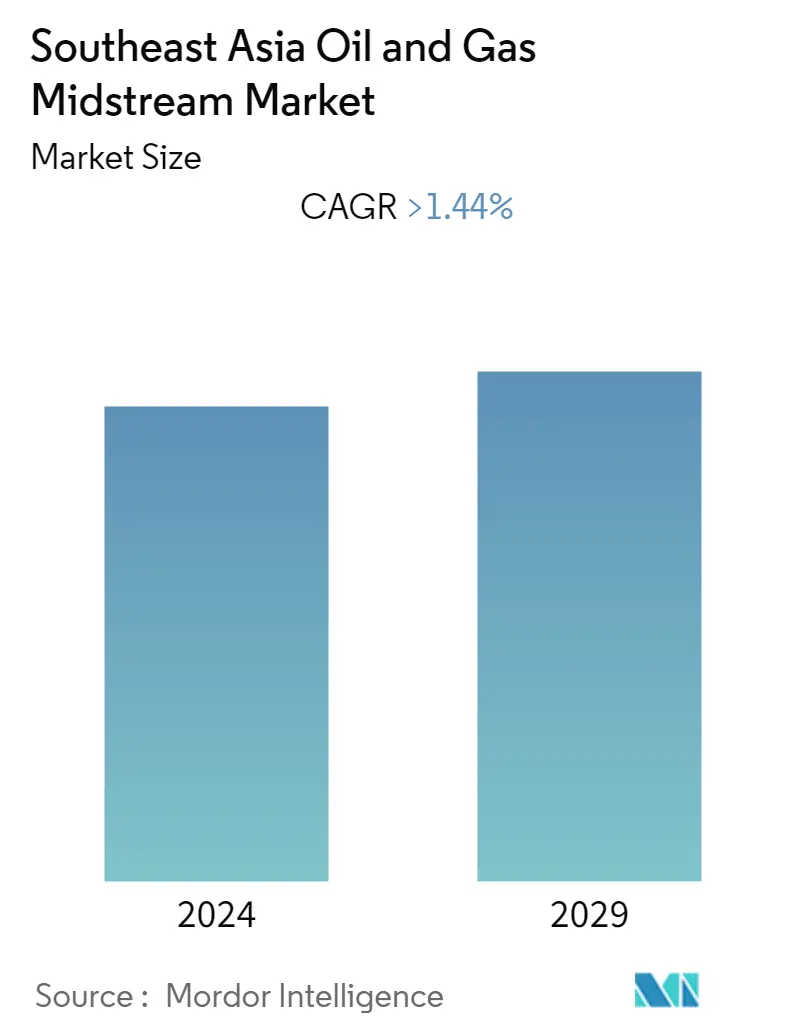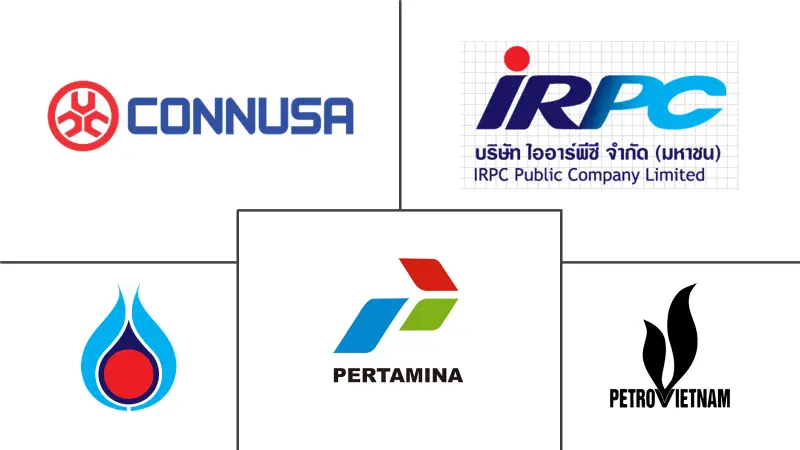
| Study Period | 2020 - 2029 |
| Base Year For Estimation | 2023 |
| Forecast Data Period | 2024 - 2029 |
| Historical Data Period | 2020 - 2022 |
| CAGR | 1.44 % |
| Market Concentration | High |
Major Players
*Disclaimer: Major Players sorted in no particular order |
Southeast Asia Oil & Gas Midstream Market Analysis
Southeast Asia oil and gas midstream market is expected to grow at a CAGR of over 1.44% during the forecast period of 2020 - 2025. Factors such as increasing demand for natural gas and oil and increasing investment are expected to boost the demand for the Southeast Asia oil and gas midstream market during the forecast period. However, decreasing the production of oil and gas in the region is expected to impede the growth in the market.
- The pipeline capacity in the region is expected to witness growth in the forecast period as many countries, in the region, are investing in their pipeline, storage, and LNG terminals projects. Increasing the consumption of oil and natural gas is also expected to aid growth.
- Major overhauling of oil and gas laws in large countries like Indonesia are expected to lead to an increase in foreign direct investment in the country and thereby increase the growth in the oil and gas midstream sector.
- Thailand oil and gas midstream industry are expected to witness growth in the forecast period due to the upcoming pipeline infrastructure projects in the country and increase in consumption of oil.
Southeast Asia Oil & Gas Midstream Industry Segmentation
The Southeast Asia oil and gas midstream market report include:
| Overview | Existing Infrastructure |
| Projects in pipeline | |
| Upcoming projects |
| Overview | Existing Infrastructure |
| Projects in pipeline | |
| Upcoming projects |
| Overview | Existing Infrastructure |
| Projects in pipeline | |
| Upcoming projects |
| Thailand |
| Vietnam |
| Malaysia |
| Indonesia |
| Rest of Southeast Asia |
Southeast Asia Oil and Gas Midstream Market Size Summary
The Southeast Asia oil and gas midstream market is poised for growth, driven by increasing demand for natural gas and oil, alongside rising investments in infrastructure. The region is witnessing significant developments in pipeline, storage, and LNG terminal projects, which are expected to enhance pipeline capacity. However, the market faces challenges due to declining oil and gas production in some areas. Major regulatory changes in countries like Indonesia are anticipated to attract foreign direct investment, further bolstering the sector's expansion. Thailand's midstream industry is also expected to grow, supported by new pipeline infrastructure projects and increased oil consumption.
The region's pipeline infrastructure is set to expand, with countries like Indonesia leading in network development. Singapore is transitioning towards LNG to meet its natural gas demands, planning to enhance its LNG import capacity with a new floating regasification plant. The consumption of natural gas has seen a slight increase, positively impacting sector growth. Thailand, as a significant oil consumer and producer, is enhancing its gas pipeline infrastructure to strengthen its position as an LNG hub in Southeast Asia. The market is moderately consolidated, with key players including PT Pertamina, PTT Public Company Limited, and TechnipFMC plc, among others, driving the sector's development.
Southeast Asia Oil and Gas Midstream Market Size - Table of Contents
1. MARKET SEGMENTATION
-
1.1 Transportation
- 1.1.1 Overview
- 1.1.1.1 Existing Infrastructure
- 1.1.1.2 Projects in pipeline
- 1.1.1.3 Upcoming projects
-
1.2 Storage
- 1.2.1 Overview
- 1.2.1.1 Existing Infrastructure
- 1.2.1.2 Projects in pipeline
- 1.2.1.3 Upcoming projects
-
1.3 LNG Terminals
- 1.3.1 Overview
- 1.3.1.1 Existing Infrastructure
- 1.3.1.2 Projects in pipeline
- 1.3.1.3 Upcoming projects
-
1.4 Geography
- 1.4.1 Thailand
- 1.4.2 Vietnam
- 1.4.3 Malaysia
- 1.4.4 Indonesia
- 1.4.5 Rest of Southeast Asia
Southeast Asia Oil & Gas Midstream Market Research FAQs
What is the current Southeast Asia Oil and Gas Midstream Market size?
The Southeast Asia Oil and Gas Midstream Market is projected to register a CAGR of greater than 1.44% during the forecast period (2025-2030)
Who are the key players in Southeast Asia Oil and Gas Midstream Market?
PTT Public Company Limited, PT Pertamina, TechnipFMC plc, Vietnam Oil and Gas Group and PT. Connusa Energindo are the major companies operating in the Southeast Asia Oil and Gas Midstream Market.


